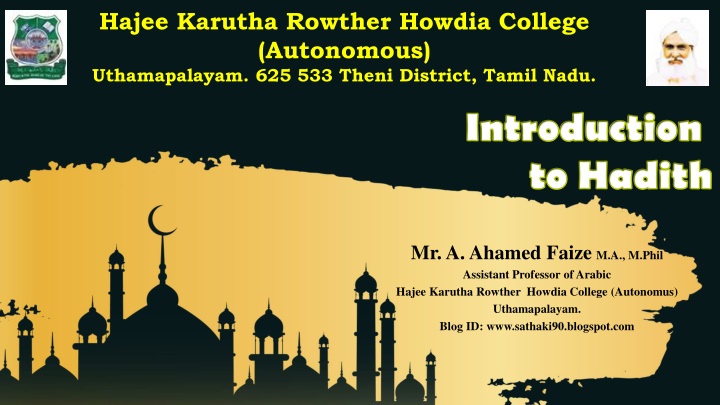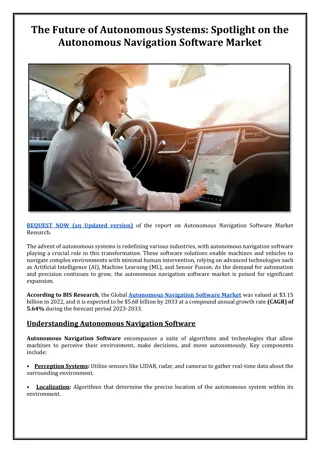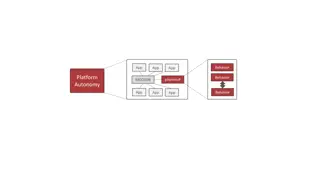Hajee Karutha Rowther Howdia College (Autonomous) - Introduction to Hadith
This content introduces the course "Introduction to Hadith" at Hajee Karutha Rowther Howdia College (Autonomous) in Uthamapalayam, Tamil Nadu. Taught by Mr. A. Ahamed Faize, M.A., M.Phil, Assistant Professor of Arabic, this course provides a comprehensive understanding of Hadith, a crucial element in Islamic scholarship.
Download Presentation

Please find below an Image/Link to download the presentation.
The content on the website is provided AS IS for your information and personal use only. It may not be sold, licensed, or shared on other websites without obtaining consent from the author.If you encounter any issues during the download, it is possible that the publisher has removed the file from their server.
You are allowed to download the files provided on this website for personal or commercial use, subject to the condition that they are used lawfully. All files are the property of their respective owners.
The content on the website is provided AS IS for your information and personal use only. It may not be sold, licensed, or shared on other websites without obtaining consent from the author.
E N D
Presentation Transcript
Hajee Karutha Rowther Howdia College (Autonomous) Uthamapalayam. 625 533 Theni District, Tamil Nadu. Introduction to Hadith Mr. A. Ahamed Faize M.A., M.Phil Assistant Professor of Arabic Hajee Karutha Rowther Howdia College (Autonomus) Uthamapalayam. Blog ID: www.sathaki90.blogspot.com
Introduction As the final Messenger of Allah, Muhammad has a special place in the history and culture of Islam. Not only was Muhammad the leader of the Muslim community, and the vehicle through whom the Qur`an was revealed, but he was also considered, by virtue of his status as a Messenger of God, to be close to God and to be a suitable model for human behavior. Because of this, Muhammad's leadership guided the community while he was alive, but his example was believed to be normative long after his death. Given this importance, the Muslim community recorded his words and actions for posterity, and as the number of these reported conversations grew exponentially in the century after his death, the community developed sophisticated methods for evaluating their veracity. Since these Hadith were an important source for the development of Islamic law, it was essential for the community to know which traditions were the most reliable, and which were clearly fraudulent. The two earliest most important figures in compiling these traditions and evaluating their authenticity were Bukhari (d. 870 CE) and Muslim (d. 875), although there were others. 2
Text & Chain of Transmission A Hadith is composed of two major parts: the text (which gave the actual content) and the chain of transmission (which named the people who had reported this, going back to the time of the Prophet. Text (actual content) The text of the report was usually not questioned, unless it was contradicted by a more authoritative source--either the Qur`an, or a better-attested Hadith. Chain of Transmission (isnad) The reliability of Hadith were usually judged by evaluating the chain of transmission, according to the criteria below. 3
Hadith Classifications Sahih ("exact") Hasan ("Fair") Daif ("Weak") Munkar ("denounced) Maudu ("forged") 4
Sahih ("exact") Sahih Hadith (the most reliable) are of two sorts: 1. If the isnad has many transmitters in every single generation. 2. If a Hadith with an unbroken isnad has only a few transmitters (one, two, etc.) in any generation, it is reliable if and only if the transmitters were pious Muslims, truthful, reliable, of an age to understand exactly what they were learning, and reported the Hadith s text verbatim. 5
Hasan ("Fair") Hasan Hadith are less reliable than the Sahih Hadith. These are Hadith in which the isnad is reliable and unambiguous, but the tradition is not as strong as for a Sahih Hadith. 6
Daif ("Weak") Unreliable traditions, either because 1. The isnad is interrupted, and thus the chain of eyewitness testimony does not go all the way back to the Prophet, OR 2. One or more of the reporters is considered unreliable (e.g., lacking true piety, being a liar, drinking alcohol, poor memory, or any other factor impugning that person's testimony). 7
Munkar ("denounced) & Maudu ("forged") Munkar ("denounced)" A Hadith reported by a weak narrator, whose content runs counter to a better-attested Hadith; this has no authority, and is denounced. Maudu ("forged") A forged Hadith. This clearly has no authority. 8
Conclusion One of the sub-disciplines of Hadith criticism was extensive biographical information for the people mentioned in the Hadith. One reason for this was to list the character factors that would be necessary to be a reliable transmitter, but the biographies also listed biographical information about people s eras and native places, contacts, travels, and personal habits. These latter were done to help establish an unbroken isnad, since if a Hadith claimed that Person A had learned it from person B, but if these two people did not live in the same era or in the same place, that Hadith was clearly unreliable. The energy and vigor that the early Muslim community put into this is a clear sign of how important getting this right was to them. 9
Thank You 10























